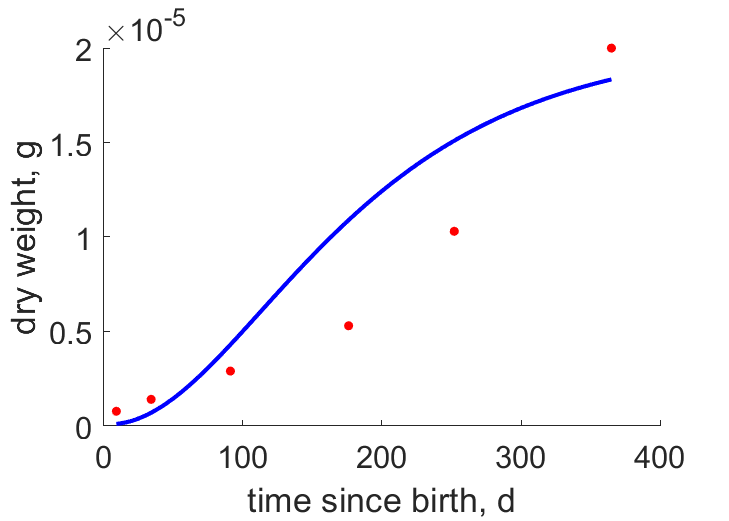Predictions & Data for this entry
| Model: abj | climate: A, B, C, D | migrate: | phylum: |
| COMPLETE = 2.5 | ecozone: TH, TA, TN, TP | food: biD, biHa | class: |
| MRE = 0.106 | habitat: 0iFm, 0iFp, 0iSm | gender: D | order: |
| SMSE = 0.024 | embryo: Fbf | reprod: Apf | family: |
Zero-variate data
| Data | Observed | Predicted | (RE) | Unit | Description | Reference |
|---|---|---|---|---|---|---|
| ab | 10 | 9.442 | (0.05579) | d | age at birth | Heip1976 |
| tp | 100 | 139.1 | (0.3909) | d | time since birth at puberty | Heip1976 |
| am | 365 | 364.9 | (0.0003677) | d | life span | Heip1976 |
| Lb | 0.13 | 0.1354 | (0.04158) | cm | shell length at birth | Heip1976, HermHeip1982 |
| Lp | 0.75 | 0.7649 | (0.01981) | cm | shell length at puberty | Heip1976 |
| Li | 1.1 | 1.037 | (0.05706) | cm | ultimate shell length | HermHeip1982 |
| Wdb | 4.5e-08 | 4.532e-08 | (0.007141) | g | dry weight at birth | HermHeip1982 |
| Wdp | 1.03e-05 | 8.168e-06 | (0.207) | g | dry weight at puberty | HermHeip1982 |
| Wdi | 2e-05 | 2.037e-05 | (0.01858) | g | ultimate dry weight | HermHeip1982 |
| Ri | 0.1 | 0.1001 | (0.001203) | #/d | maximum reprod rate | Heip1976 |
Uni- and bivariate data
| Data | Figure | Independent variable | Dependent variable | (RE) | Reference |
|---|---|---|---|---|---|
| tW |  | time since birth | dry weight | (0.3644) | HermHeip1982 |
Pseudo-data at Tref = 20°C
| Data | Generalised animal | Cyprideis torosa | Unit | Description |
|---|---|---|---|---|
| v | 0.02 | 0.004121 | cm/d | energy conductance |
| kap | 0.8 | 0.9901 | - | allocation fraction to soma |
| kap_R | 0.95 | 0.95 | - | reproduction efficiency |
| p_M | 18 | 258.8 | J/d.cm^3 | vol-spec som maint |
| k_J | 0.002 | 0.002 | 1/d | maturity maint rate coefficient |
| kap_G | 0.8 | 0.8006 | - | growth efficiency |
Discussion
- (ap,Wdp) is not on the data-curve for t-Wd
Facts
- Cyprideis torosa is a very important meiofauna species in the shallow brackish water habitat we studied. The animals develop through eight larval instars before becoming adult. The eggs are produced during the summer months and are contained between the shells of the mother, as are the instar I animals. In autumn the development of the juveniles slows down and it stops altogether in winter. Due to this prolonged reproduction the population passes the winter in different stages (instar V to adult). Only in the next spring do overwintering juveniles become adult and reproduce. The species thus has one generation annually. (Ref: Heip1976)
Bibliography